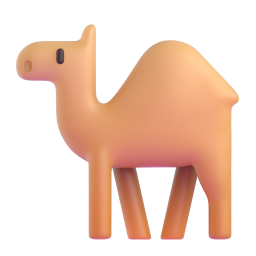🐪 Dromedary Camel
Also known as: Arabian Camel, Dromedary Camel, One-Bump Camel
Description
A dromedary camel, a long-necked mammal with one large hump on its back. Depicted in light or yellowish brown in full profile on all fours facing left. Not to be confused with 🐫 Two-Hump Camel (Bactrian), though their applications generally overlap. May be used in association with deserts, the Middle East, and Wednesday (Hump Day). Samsung’s design features a camel with a shaggy head of hair and slight smile. Google’s design previously featured a blanket on its back, as for transport.
Image Variants

3D
Color
Flat
High Contrast
Version Information
Keywords
Shortcodes
| Platform | Shortcode | Action |
|---|---|---|
| Emojipedia | :camel: | |
| GitHub | :dromedary_camel: | |
| Slack | :dromedary_camel: | |
| Discord | :dromedary_camel: |
Additional Information
A camel with one bump, found in parts of Africa and India. More common than the two-bump Bactrian Camel. Camel was approved as part of Unico http://emojipedia.org/dromedary-camel/
- Extrusion is a process used to create objects of a fixed cross-sectional profile.
- Motion, the process of movement, is described using specific anatomical terms.
- Something that bulges out or is protuberant or projects from its surroundings
- A bulge: something that bulges out or is protuberant or projects from a form
- Cud-chewing mammal used as a draft or saddle animal in desert regions
- Even-toed ungulate within the genus Camelus
- A beast of burden, much used in desert areas, of the genus Camelus.
- A camel is a large mammal, used in the Middle East as a beast of burden.
- A camel is an even-toed ungulate within the genus Camelus, bearing distinctive fatty deposits known as "humps" on its back.
- Beast of burden.
- A one-humped camel (Camelus dromedarius) of the hot deserts of northern Africa and south western Asia.
- The dromedary, also called the Arabian camel or the Indian camel, is a large, even-toed ungulate with one hump on its back.

